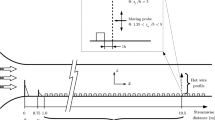Abstract
Flow in the urban boundary layer is strongly influenced by the surface roughness, which is composed principally of isolated buildings or groups of buildings. Previous research has shown that the flow regime depends on the characteristic height of these obstacles (H), and the spacing between them (W). In reality, the urban boundary layer contains roughness elements with a wide range of length scales; in many practical situations these can be classified into large-scale roughness—buildings, or groups of buildings—and small-scale roughness, such as street furniture and elements on the façades and roofs. It is important to understand how the small-scale roughness might modify mass and momentum transfer in the urban boundary layer, but relatively little information is available concerning the potential interaction between large- and small-scale roughness elements in the different flow regimes. This problem has been studied using wind-tunnel experiments, by measuring vertical velocity profiles over a two-dimensional obstacle array, adding small-scale roughness elements to the top of larger parallel square bars. The experiments were performed for different cavity aspect ratios: the results show that the small-scale roughness increases the turbulence intensities and the momentum transfer when the large-scale obstacles are closely packed (H/W > 1) but it has very little effect for more widely-spaced obstacles (H/W < 1).
Similar content being viewed by others
References
Antonia RA and Krogstad PA (2001). Turbulence structure in boundary layers over different types of surface roughness. Fluid Dyn Res 28: 139–157
Athanassiadou M and Castro IP (2001). Neutral flow over a series of rough hills: a laboratory experiment. Boundary-Layer Meteorol 101: 1–30
Counihan J (1969). An improved method of simulating an atmospheric boundary layer in a wind tunnel. Atmos Env 3: 197–214
Gong W, Taylor PA, D\({\ddot{o}}\)rnbrack A (1996) Turbulent boundary-layer flow over fixed aerodynamically rough two-dimensional sinusoidal waves. J Fluid Mech 312:1–37
Irwin HPAH (1981). The design of spires for wind simulation. J Wind Eng and Indust Aerod 7: 361–366
Krogstad PA, Antonia RA (1999) Surface roughness effects in turbulent boundary layers. Expts Fluids 27:450–460
Mulhearn PJ (1978). Turbulent flow over a periodic rough surface. Phys Fluids 21(7): 1113–1115
Mulhearn PJ and Finnigan JJ (1978). Turbulent flow over a very rough random surface. Boundary-Layer Meteorol 15: 109–132
Nikuradse J (1933). Strömungsgesetze in rauhen Rohren. Forschg Arb Ing-Wes 361: 1–22
Oke TR (1987). Boundary layer climates, 2nd edn. Methuen, London, 435
Perry A, Lim K and Henbest S (1986). An experimental study of the turbulence structure in smooth- and rough- wall boundary layers. Fluid Mech 177: 437–466
Perry A, Shofield WH and Joubert PN (1968). Rough wall turbulent boundary layers. J Fluid Mech 37: 383–413
Rafailidis S (1997). Influence of building areal density and roof shape on the wind characteristics above a town. Boundary-Layer Meteorol 85: 255–271
Raupach MR (1992). Drag and drag partition on rough surfaces. Boundary-Layer Meteorol 60: 375–395
Raupach MR, Antonia R and Rajoplan S (1991). Rough-wall turbulent boundary layers. Appl Mech Rev 44(1): 1–25
Raupach MR, Hughes HA and Cleugh DE (2006). Momentum absorption in rough-wall boundary layers with sparse roughness elements in a random and clustered distributions. Boundary-Layer Meteorol 120: 201–218
Raupach MR, Thom AS and Edwards I (1980). A wind-tunnel study of turbulent flow close to regularly arrayed rough surfaces. Boundary-Layer Meteorol 18: 373–397
Soulhac L (2000) Modélisation de la dispersion atmosphérique à l’intérieur de la canopée urbaine. Ph.D. thesis, Ecole Centrale de Lyon
Tennekes H, Lumley JL (1972) A first course in turbulence. The MIT Press, 300 pp
Author information
Authors and Affiliations
Corresponding author
Rights and permissions
About this article
Cite this article
Salizzoni, P., Soulhac, L., Mejean, P. et al. Influence of a Two-scale Surface Roughness on a Neutral Turbulent Boundary Layer. Boundary-Layer Meteorol 127, 97–110 (2008). https://doi.org/10.1007/s10546-007-9256-8
Received:
Accepted:
Published:
Issue Date:
DOI: https://doi.org/10.1007/s10546-007-9256-8




